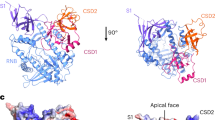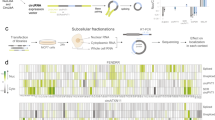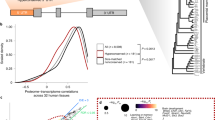Abstract
THE nucleoli of eukaryotic cells are the sites of ribosomal RNA transcription and processing and of ribosomal subunit assembly. They contain multiple small nucleolar RNAs (snoRNAs), several of which are essential for rRNA maturation1. The U3, U8 and U13 snoRNA genes are transcribed independently, whereas U14–U24, as well as E3, are located within introns of protein-coding genes, most of whose functions are linked to translation. These snoRNAs are co-transcribed with their host pre-mRNAs and released by processing from excised introns1,2. Here we show that, in addition to U22, seven novel fibrillarin-associated snoRNAs, named U25–U31, are encoded within different introns of the unusually compact mammalian U22 host gene (UHG). All seven RNAs exhibit extensive (12–15 nucleotides) complementarity to different segments of the mature rRNAs, followed by a C/AUGA ('U-turn') sequence. The spliced UHG RNA, although it is associated with polysomes, has little potential for protein coding, is short-lived, and is poorly conserved between human and mouse. Thus, the introns rather than the exons specify the functional products of UHG.
This is a preview of subscription content, access via your institution
Access options
Subscribe to this journal
Receive 51 print issues and online access
$199.00 per year
only $3.90 per issue
Buy this article
- Purchase on Springer Link
- Instant access to full article PDF
Prices may be subject to local taxes which are calculated during checkout
Similar content being viewed by others
References
Maxwell, E. S. & Fournier, M. J. A. Rev. Biochem. 35, 899–934 (1995).
Sollner-Webb, B. Cell 75, 403–405 (1993).
Tycowski, K. T., Shu, M.-D. & Steitz, J. A. Science 266, 1558–1561 (1994).
Mager, W. H. Biochem. biophys. Acta 949, 1–15 (1988).
Greenberg, M. & Belasco, J. G. in Control of Messenger RNA Stability (eds Belasco J. & Brawerman G.) 199–218 (Academic, San Diego, 1993).
Maquat, L. E. RNA 1, 453–465 (1995).
Bachellerie, J.-P. et al. Trends biochem. Sci. 20, 261–264 (1995).
Pellizzoni, L., Crosio, C., Campioni, N., Loreni, F. & Pierandrei-Amaldi, P. Nucleic Acids Res. 22, 4607–4613 (1994).
Rimoldi, O. J., Raghu, B., Nag, M. K. & Eliceiri, G. L. Molec. cell. Biol. 13, 4382–4390 (1993).
Pley, H. W., Flaherty, K. M. & McKay, D. B. Nature 372, 68–74 (1994).
Scott, W. G., Finch, J. T. & Klug, A. Cell 81, 991–1002 (1995).
Quigley, G. J. & Rich, A. Science 194, 796–806 (1976).
Mattick, J. S. Curr. Opin. genet. Dev. 4, 823–831 (1994).
Geyer, P. K., Meyuhas, O., Perry, R. P. & Johnson, L. F. Molec. cell. Biol. 2, 685–693 (1982).
Nucifora, G., Begy, C. R., Erickson, P., Drabkin, H. A. & Rowley, J. D. Proc. natn. Acad. Sci. U.S.A. 90, 7784–7788 (1993).
Tyc, K. & Steitz, J. A. EMBO J. 8, 3113–3119 (1989).
Author information
Authors and Affiliations
Rights and permissions
About this article
Cite this article
Tycowski, K., Shu, MD. & Steitz, J. A mammalian gene with introns instead of exons generating stable RNA products. Nature 379, 464–466 (1996). https://doi.org/10.1038/379464a0
Received:
Accepted:
Issue Date:
DOI: https://doi.org/10.1038/379464a0
This article is cited by
-
Intron size minimisation in teleosts
BMC Genomics (2022)
-
snoRNAs: functions and mechanisms in biological processes, and roles in tumor pathophysiology
Cell Death Discovery (2022)
-
Long non-coding RNA small nucleolar RNA host genes: functions and mechanisms in hepatocellular carcinoma
Molecular Biology Reports (2022)
-
Transcriptional regulation of snRNAs and its significance for plant development
Journal of Plant Research (2017)
-
Deep intronic mutations and human disease
Human Genetics (2017)
Comments
By submitting a comment you agree to abide by our Terms and Community Guidelines. If you find something abusive or that does not comply with our terms or guidelines please flag it as inappropriate.



